By Philip Cauchi
Introduction: In this fourth session the main emphasis is on the collaboration of three defenders working together to prevent conceding a goal and win the ball. We will make use of situations which requires the three defenders to communicate well with each other. They will learn to keep compact, remain patient, mark and track attackers intelligently and time the moment when to attack the ball carrier to reconquer possession. We want to start by building a mental picture of the principles of group defending in the players’ minds.
Session number: 4 of 8.
Players: Two goalkeepers and sixteen outfield players.
Total duration: 90 minutes.
Moment of play: Opponents in possession.
Team task: Prevent scoring.
Theme: Defend to win the ball.
Main aim: Prevent opponents from scoring.
Outcomes:
1. Force play away from goal.
2. Timing to tackle to win the ball.
3. Cover to the defender applying pressure on the ball.
4. Marking of direct opponent inside the defender’s zone.
5. Cut off shooting options.
6. Compactness.
Equipment:
Balls, bibs (two colours), markers, mini goals (four) and two regular goalposts.
Activation 1: Dribble tag.
Targeted outcomes: n/a.
Duration: 5 minutes.
Players: Three groups of one tagger and five dribblers.
Area: Three setups each measuring 8 yards by 8 yards.
Description: All players – even the tagger – with a ball at their feet. One of the players is the tagger and tries to tag as many players as possible within a forty second time frame. All the players must remain inside the marked area, otherwise the players dribbling the ball out of it will be counted as if they were tagged. After every repetition have a different player to be the tagger. Perform the exercise as a competition between the players of who of them is able to tag the most players in the allotted time.
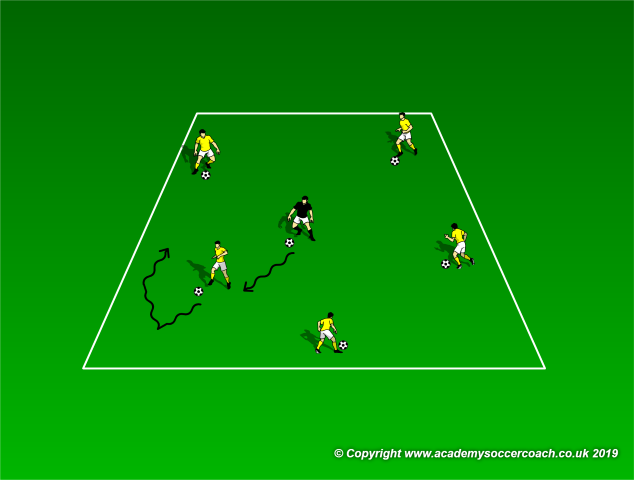
Activation 2: Rapidity tag game.
Targeted outcomes: n/a.
Duration: 5 minutes.
Players: Three groups of one tagger and five free players.
Area: Three setups each measuring 8 yards by 8 yards.
Description: The tagger’s aim is to tag as many players as possible within a fifteen second period. After this period change the tagger. Perform the activity as a competition between players. Who of them is able to tag the most players in the allotted time? This activity is more intense than the previous one and we now focus on engaging the players’ nervous system to perform fast and rapid movements. This is a pre-requisite for the exercise that follows.
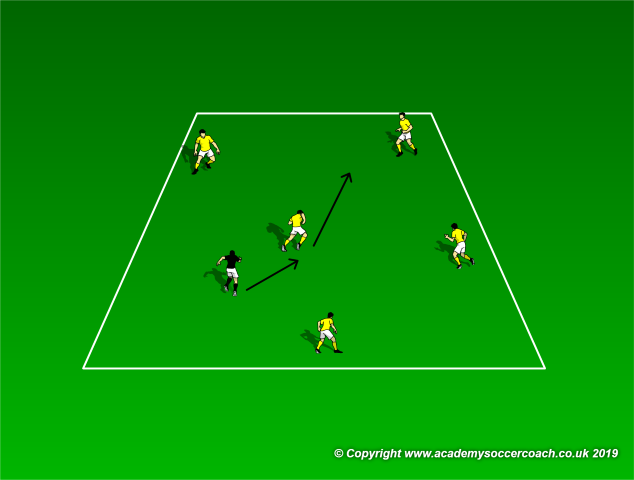
1v1 with reaction speed: Lateral gates game.
Targeted outcomes: 1 and 2.
Duration: 10 minutes.
Players: Two groups of eight players where each group is divided into two subgroups.
Area: Two setups each measuring 10 yards by 20 yards.
Description: Attacker (black) with a ball and aims to disguise the defender (yellow) to dribble either past the blue or red gate. The defender aims to prevent the attacker from dribbling through the designated gate. Once the attacker is outside the orange square s/he cannot change direction and attack the opposite gate. Both players start from the positions as shown in the diagram below. After each repetition players switch roles. Who was defending now attacks and vice versa. Perform two series of six repetitions, therefore each player plays six times as an attacker and six times as a defender. The activity may also be progressed by having both players passing back and forth to each other and then at the discretion of the attacker, s/he attacks a gate.
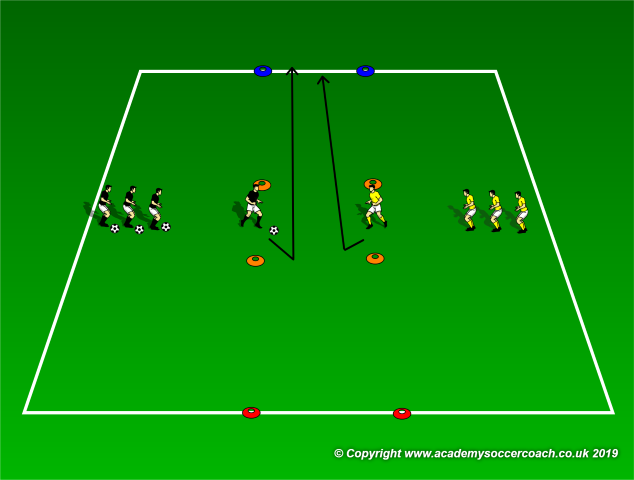
Game situation training: 3v3+GK and two neutral flank players.
Targeted outcomes: 1, 2, 3, 4, 5 and 6.
Duration: 15 minutes (four x three minutes with one minute of rest).
Players: Two groups of eight players. In each group we have a goalkeeper, two teams of three players and two neutrals.
Area: Two setups each measuring 25 yards by 30 yards.
Description: The defending team (yellows) aims to prevent the attacking team from scoring, win the ball, and score in the mini goals. The two neutral players play inside the flank zones and with the team in possession, but are not allowed to score. Each team plays two games as defenders and two games as attackers. As a progression the flank players may cut inside to score. This increases the challenge of the defending team as they will be in a numerical disadvantage of 3v5 where all opponents can score. In the below diagram we have two setups of the same activity.
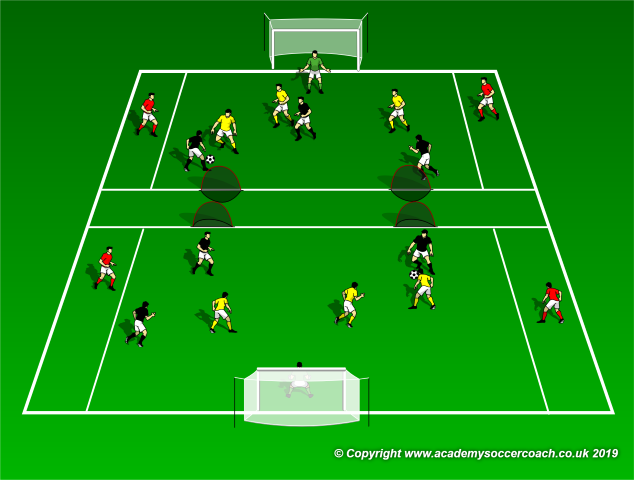
Game: 7v7 + four neutral flank players.
Targeted outcomes: 1, 2, 3, 4, 5 and 6.
Duration: 18 minutes (two x eight minutes with two minutes of rest).
Players: Two groups of eight players. In each group we have a goalkeeper, two teams of three players and two neutrals.
Area: 55 yards by 30 yards divided into two zones.
Description: The playing area is divided into two equal horizontal zones. In each halve (zone) we have a 3v3 plus two neutrals, one on each flank. Players are however restricted to remain inside their assigned half of the pitch. The neutral players play with the team in possession and may cut inside with the ball to score. This setup simulates the game on a larger scale using the 1-3-3 formation and the neutral players as fullbacks and wingers in the offensive phase.
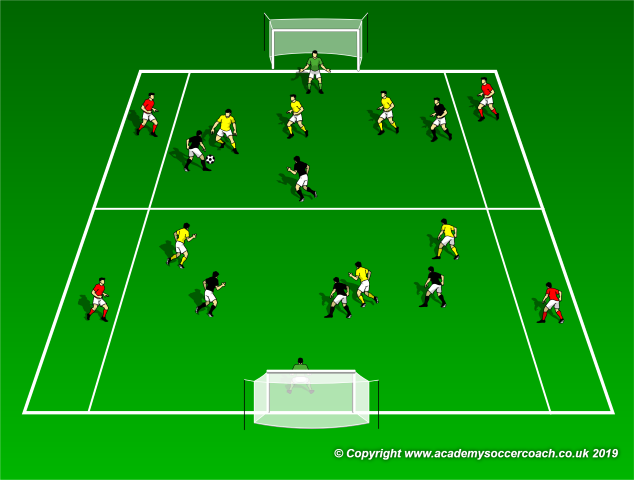
Game: 7v7 + four neutral flank players.
Targeted outcomes: 1, 2, 3, 4, 5 and 6.
Duration: 18 minutes (two x eight minutes with two minutes of rest).
Players: Two groups eight players. In each group we have a goalkeeper, two teams of three players and two neutrals.
Area: 55 yards by 30 yards with flank zones that are four yards in width.
Description: We integrate both areas shown in the above diagram to play a match of 7v7+4 neutrals. The neutral players are positioned in the flank zones. At first they are not allowed to score. As we progress the neutral players may move inside and are allowed to score. However, when this happens there should always be at least a neutral player in each flank zone providing width.
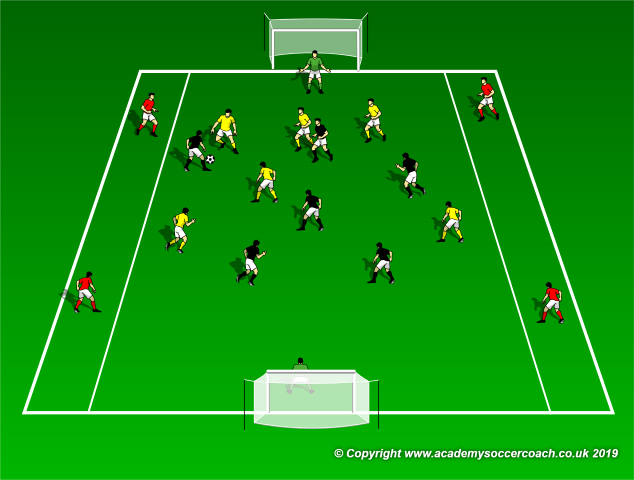
Conclusive Part.
Duration: 10 minutes.
In the conclusive part the players perform light ball activities such as dribbling using feints and fakes at their discretion. Static stretching exercises may also be carried out in the final five minutes.
By Philip Cauchi


